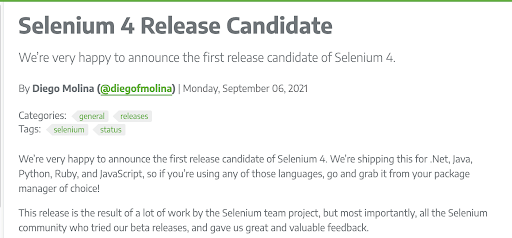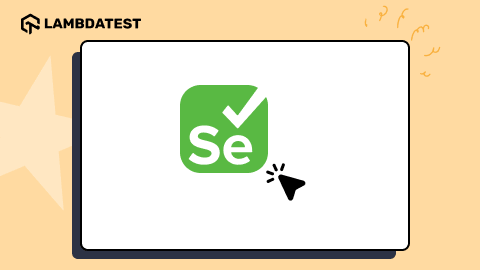Debunking The Top 8 Selenium Testing Myths
Gunjan Kaushik
Posted On: September 16, 2021
![]() 119060 Views
119060 Views
![]() 10 Min Read
10 Min Read
When it comes to web automation testing, the first automation testing framework that comes to mind undoubtedly has to be the Selenium framework. Selenium automation testing has picked up a significant pace since the creation of the framework way back in 2004.
Developers and the QA community hail open-source frameworks like Selenium, since it has a huge community and supports major programming languages like Python, C#, Java, JavaScript, Ruby, and PHP. But, that’s not all. It is relatively easy to port web automation tests from the local Selenium Grid to a cloud-based Selenium Grid like LambdaTest. As per the State of the Open Source report, Selenium is still the king of web automation and holds close to 81 percent market share in this crowded test automation tools market, debunking any Selenium testing myths.
If you’d like to run your test scripts over a Selenium Grid online then leverage LambdaTest for your test automation.👇
Fast forward now, Selenium 3.141.59 is the latest stable version of Selenium, and Selenium 4 release is just around the corner. A few weeks back, the Selenium community released the RC1 (Release Candidate – 1) of the most awaited version of Selenium 4.

Even though Selenium is extremely popular for web automation testing, many QA engineers have numerous Selenium testing myths about various facets of the Selenium framework. In this blog, we try to debunk the misconceptions or Selenium testing myths that revolve around the Selenium framework.
TABLE OF CONTENT
- Being open-source, Selenium has numerous limitations
- Selenium is not secure
- Selenium is not suited for large enterprises
- Selenium does not have a proper release cycle
- Selenium updates break the existing working implementation
- Selenium can be used to test APIs
- Selenium can be used for performance testing
- Selenium can automate testing of desktop automation
Myth #1 Being open-source, Selenium has numerous limitations
Open-source software is one of the most important models to ensure transparency and accountability. Unfortunately, many developers and QA engineers see paid tools as being better than open-source software because there is a misconception that good product features come at a significant cost. This can be attributed to the fact that most people consider open source solutions to be less intuitive, incomplete, or an alternative solution to paid software solutions. However, this discussion does not hold good for the Selenium framework.
Selenium being an open-source framework, has a large community of contributors who keep the project up to date, and it is very easy for any QA engineer to find solutions around Selenium from forums like Stack Overflow, Selenium Slack Community, amongst others. At the time of writing this blog, Stack Overflow has close to 89,000+ questions with the Selenium tag.

Apart from these forums, you can also latch on to the LambdaTest Selenium community if you need answers around Selenium automation testing, Selenium automation frameworks, and more. But, that’s not all. You can also check Selenium documentation on the official website if you are just getting started with the framework or looking to try out the new features in the framework.
Myth #2 Selenium is not secure
The occurrence of data breaches has increased significantly over the past decade. It’s no surprise given the number of sophisticated hackers who constantly discover security vulnerabilities in everything from web applications to Internet of Things (IoT) devices.
Obviously, no open-source software or proprietary framework can guarantee the best security.
For something like Selenium, which is sponsored by the reputable Apache Software Foundation, this does not apply. Selenium is an integrated suite of tools and frameworks, which allows teams to perform automated and manual testing, ensuring the security of all the critical information, critical systems, and the information in transit.
However, a common misconception among testers is that Selenium tests are slow and extremely flaky. To dispel these notions and effectively harness the power of Selenium, test teams must understand how they can improve their efficiency and develop high-quality software.
Selenium, as a framework for supporting automated testing, is robust. This condition is an important factor for ensuring comprehensive automated testing. Another critical element for this purpose is testing on real devices and different browser & platform conditions for improving test coverage.
Read – Code Coverage vs. Test Coverage
A cloud-based cross browser testing solution like LambdaTest, which is GDPR and SOC2 compliant, helps QA testers to run their Selenium tests on cloud browsers and real device cloud to assure accuracy and proximity to real user conditions.
Myth #3 Selenium is not suited for large enterprises
Over the past several years, several automation tools like Cypress framework have been released as there are umpteen benefits of test automation. Though companies and individual developers have been trying out new test automation tools, Selenium is still the most preferred framework for web automation testing.
Many QA engineers have the misconception that Selenium is not enterprise-worthy just because it’s a free tool. However, this misconception is utterly false, as Selenium is a product of the Apache Software Foundation (ASF).
Selenium has become a powerful solution as it can be used for automating business-critical applications like large-scale e-commerce websites, government websites, and more. It is incorporated into even the most stringent automation projects at some of the world’s leading e-commerce, cloud computing, and SaaS companies, including Netflix, Bloomberg, The New York Times, Twitter, eBay, Yahoo!, PayPal, WordPress.com, LambdaTest, and more.
Enterprises looking to leverage the Selenium framework for realizing large-scale web automation testing have the flexibility to choose a cloud-based Selenium Grid like LambdaTest. Such a solution reduces the overhead cost of maintaining in-house infrastructure and helps improve product quality by letting you run automation tests across a range of browser and OS combinations.
Read – Why Selenium Grid Is Ideal For Automated Browser Testing?
Myth #4 Selenium does not have a proper release cycle
There are many myths about open-source software, but one of the most pervasive one is that open-source software lacks the resources to put forth updates. However, this is not true. Community expertise is one of the major factors behind the growth of any open-source software, and the same principle also holds good for the Selenium framework. Open-source development has access to a plethora of resources provided by fellow open-source hackers who are always willing to help out with bug fixes or updates.
With access to an entire community of developers, open-source is the most efficient and economical way to develop and advance new technologies for immediate and long-term implementation. Large tech communities collaborate and work together to leverage good ideas. Open-source projects also bring together expert individuals who work on these projects to make innovative changes and updates.
Selenium, too, has firm community support from contributors across the world. Since it was released, Selenium WebDriver has continued to progress against its goal of being a comprehensive browser automation tool. LambdaTest is also one of the sponsors of the Selenium framework. It is one of the best ways of nurturing an open-source community!
💰[Sponsor Spotlight] 🎉
Welcome aboard! @lambdatesting our new Selenium-level sponsor.
We thank you for your continued support and upgrading to our highest sponsorship level #sponsorship #testing #selenium #automationhttps://t.co/98uYyRAd1p
Checkout: https://t.co/aKWX6nTeu2— Selenium (@SeleniumHQ) July 7, 2021
The below table breaks down some of the latest Selenium releases, starting from the Selenium recent version and working back, and their key features.
|
Selenium Version |
Release Date |
Key Features |
|
Selenium 4.0 Alpha 5 (Selenium Latest Version) |
March 2020 |
|
|
Selenium 4.0 Alpha 4 |
January 2020 |
|
|
Selenium 4.0 Alpha 3 |
July 2019 |
|
Post Selenium 4 (Alpha-5), there have been numerous Alpha releases of the framework, and we are eager to get our hands dirty with the Selenium4-RC1 release.
Read – Geolocation Testing with Selenium
Myth #5 Selenium updates break the existing working implementation
Upgrading to a newer version of Selenium WebDriver requires you to upgrade your browser driver as well. However, upgrading the version will bring along with it access to new functionalities, along with ensuring backward compatibility with the previous release.
You just need to make sure that the version of the Selenium jar and the browser driver are in sync. For example, Selenium 4 is a major update over the previous stable version of Selenium (i.e., 3.141.59). In addition, Selenium 4 relative locators let you access nearby WebElements easily, thereby eliminating the need to use Selenium Web locators to locate required elements on the web page.
An army of Selenium enthusiasts are working round the clock to ensure a stable Selenium version is released to the end-users. Stability, reliability, and security are some of the major things taken care of when the community releases any major Selenium update.
Myth #6 Selenium can be used to test APIs
You might have come across the following question when working with Selenium – How can I test APIs using Selenium?
Selenium provides the flexibility to interact with the elements in the DOM by locating the Element and using appropriate Selenium methods to interact with the said element. You need to access them programmatically to test APIs, which can be done using an API testing tool like REST Assured or JMeter.
So, to answer the question, “Can I use Selenium for API testing?”, the short answer is no, but you can use REST Assured or JMeter. However, tools like LambdaTest provide REST APIs for Selenium automation to access relevant details about the tests being run on the cloud grid.
Read – Selenium Automation Best Practices
Myth #7 Selenium can be used for performance testing
Selenium is an important tool for automated testing, but many people think that test application (or website) performance can be improved with the Selenium Grid. Actually, the use of Selenium Grid is just an excuse for the poor performance of tests.
Selenium Grid helps to execute tests in parallel, thereby letting you reduce the time spent on test execution and product release. Parallel testing in Selenium Python and other Selenium-supported languages is one of the major reasons why enterprises (and developers) prefer the Selenium framework.
Standalone Selenium cannot be used for performance testing, but when integrated with JMeter can be used for load testing. Though Selenium and JMeter can be used for some level of performance testing, they can only be used for small-scale applications (or projects).
Note: Experience reliable automated testing with Selenium Testing Tool on a cloud grid of 3000+ browsers and operating systems.
Myth #8 Selenium can automate testing of desktop automation
As already said above, Selenium is a free and open-source tool that allows you to automate interaction with the WebElements on the AUT (Application Under Test). However, in order to handle anything outside of the browser’s scope (e.g., file upload or download within the windows dialog box), you need to use other tools like ROBOT and integrate them with Selenium.
On the whole, the capabilities of Selenium can be best extracted if the framework is used for web automation.
Conclusion
Selenium is the world leader in browser automation. It’s free, powerful, and extremely easy to use. But these facts have led some testers astray–they believe Selenium is limited because it’s free. So why invest in a paid tool when Selenium does everything you need?
In fact, there is no other tool in the market that offers advanced features like Selenium does while maintaining its small footprint and affordable price; and every tester needs to debunk these Selenium testing myths.
Got Questions? Drop them on LambdaTest Community. Visit now













